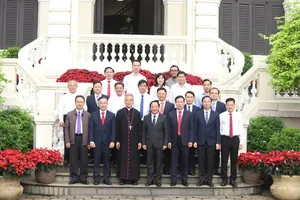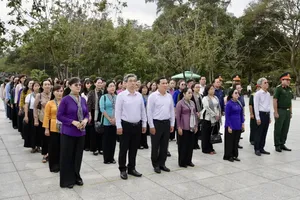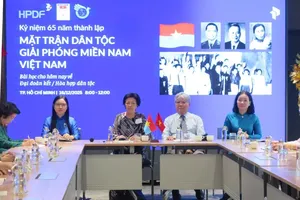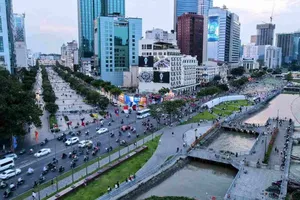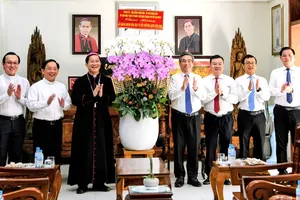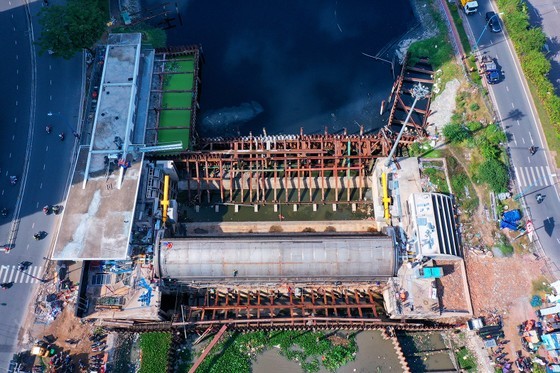 |
Ben Nghe culvert is almost completed. |
In recent days, continuous heavy rainfall along with high tides has caused severe flooding on numerous roads, particularly those adjacent to canal and ditch areas in districts 7, 8, Thu Duc City, and suburban areas like Binh Chanh and Nha Be. These conditions have significantly hindered transportation and disrupted the lives of local residents. Nevertheless, the flood prevention project that citizens have been anticipating remains at a standstill due to insufficient funding.
Abandoned projects
In addition to the small and medium flood prevention projects, citizens have placed their greatest hopes on the VND10 trillion flood prevention project. This project, managed by Trung Nam Construction Investment Corporation (Trung Nam Company) as the investor through a build-transfer (BT) contract, began in mid-2016. The project's primary aim is to control flooding caused by high tides and proactively address climate change for an area encompassing 570 square meters and housing approximately 6.5 million residents, including those residing along the Saigon River and in the heart of HCMC. Upon completion, this project will empower HCMC to actively manage and reduce water levels in canals and ditches, thereby enhancing urban drainage capabilities.
Over the past few days, at the construction site of the primary flood prevention culverts, the setting appeared remarkably barren, devoid of any human presence. Instead, concrete and steel structures lay exposed to the sun and rain. Presently, only a small contingent of security guards can be seen on-site. An official from Trung Nam Company reported that Muong Chuoi culvert has reached 93 percent completion, but progress is currently stalled due to capital constraints.
Similarly, Ben Nghe culvert has reached 97 percent completion, Tan Thuan culvert is at 93 percent, Phu Xuan culvert has achieved 90 percent, Cay Kho culvert stands at 86 percent, Phu Dinh culvert has achieved 88 percent, and the embankment line is at 85 percent completion. However, due to a funding shortage, construction has been at a standstill for several years. For over three years, most of the construction workers and engineers on the project have been unemployed.
Under the BT agreement inked between the HCMC People's Committee and Trung Nam Company, aimed at mitigating flooding resulting from high tides, the investor is slated to construct six sizable tidal control culverts. These culverts will range in width from 40-160 meters and have a culvert's bottom altitude ranging from -3.6 meters to -10 meters. Furthermore, a stretch of embankment along the Saigon River, extending from Vam Thuat to the Kinh River in Phase 1, encompassing 6 kilometers of embankment and 43 smaller culverts, will be erected.
Nonetheless, the project has experienced three temporary halts within the past seven years. The investor's representative has noted that, with the remaining work volume, should funding be disbursed and construction recommenced, it would take roughly 9-11 months to finalize the project.
"Many roads get submerged in water when it rains during high tide. People are struggling to make a living while the flood prevention project remains stagnant, even though it's nearing completion. It's genuinely disheartening," voiced Tran Thanh Quang, a resident of Phu Dinh Street in District 8.
Additional VND1.8 trillion needed for project completion
The main obstacle leading to the project's construction stoppage is the necessity for payments to enable further funding for the investor. To conclude the project, the investor needs to secure a loan of approximately VND1.8 trillion from BIDV Bank. However, BIDV Bank has not granted approval for the loan due to the project's lack of assurance regarding financial safety principles.
Regarding this issue, the HCMC People's Committee has proposed two mechanisms to the Prime Minister concerning project settlement. The first mechanism involves HCMC paying the investor for the completed work volume using both land resources and cash in accordance with the mutually agreed-upon payment schedule.
As for the cash payment aspect, HCMC suggests that the Prime Minister directs the State Bank of Vietnam to advise BIDV Bank against immediate debt collection and, instead, facilitate conditions for the investor to resume construction and finalize the project. Subsequently, HCMC and the investor will carry out an inspection and make payments for the remaining portion following the terms outlined in the signed BT contract and its annex.
The second mechanism involves HCMC proposing to the Prime Minister to allow the HCMC Finance and Investment State-owned Company (HFIC) to be entrusted with lending to continue the project using the city's budget. Accordingly, HCMC's People's Committee will allocate approximately VND1.8 trillion from the city's budget to HFIC for the investor to borrow and complete the project.
Following an analysis of the strengths and weaknesses of both mechanisms, the HCMC People's Committee recommends the Prime Minister's consideration and approval of the second mechanism due to its superior implementation benefits.
Should this mechanism be selected, HCMC will require guidance from the Ministry of Finance, relevant ministries, and agencies. The HCMC People's Committee assures that the entrusted capital provided to Trung Nam Company will be utilized for its intended purpose effectively, leading to the swift completion of the project for acceptance and its subsequent operation.
Based on the recommendation from the HCMC People's Committee, the Government Office has sought the opinions of four ministries: Planning and Investment, Finance, Agriculture and Rural Development, Construction, and the State Bank of Vietnam on the mechanism to resolve the issues for this project. This will be done before reporting to the Prime Minister for consideration and decision.
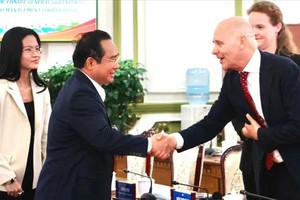


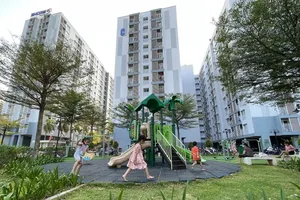

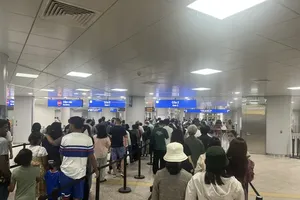
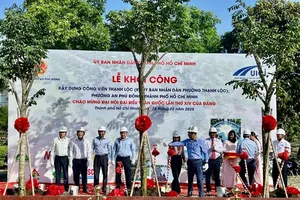
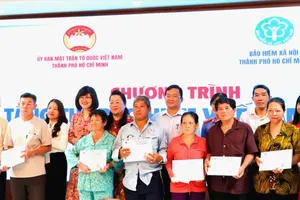
)

